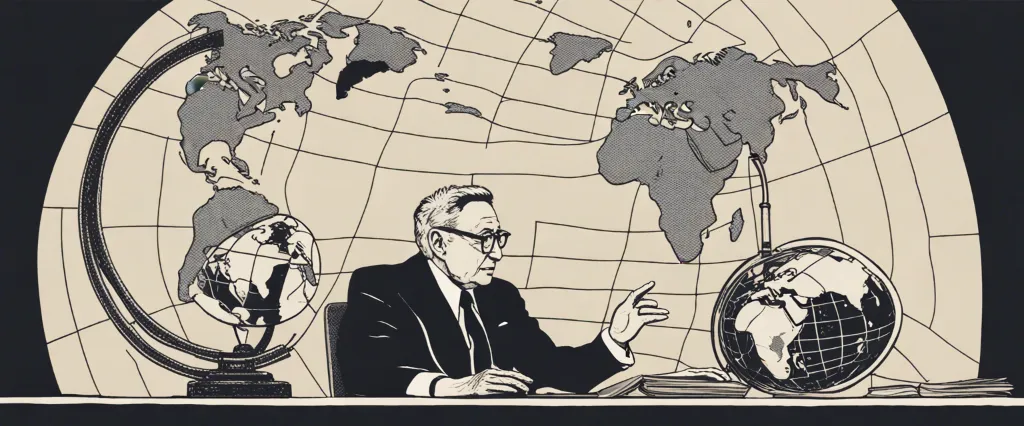
The phenomenon of world order has long captivated the minds of scholars, policymakers, and readers alike. As we navigate through the complexities of our interconnected world, understanding the forces that shape and disrupt global affairs becomes increasingly vital. In this comparative study, we delve into two thought-provoking works that explore the intricacies of world order from distinct perspectives: “World Order” by Henry Kissinger and “Upheaval” by Jared Diamond.
Henry Kissinger, a renowned statesman and political theorist, examines the concept of world order through his vast experiences in international diplomacy. In his seminal work, Kissinger appraises the historical evolution of world order, dissects the current geopolitical landscape, and offers insights into the role of diplomacy in managing the incessant struggle between nations. With remarkable depth, Kissinger aspires to shed light on the challenges that the international community faces in forging a stable and harmonious global order.
On the other hand, Pulitzer Prize-winning author Jared Diamond takes a multidisciplinary approach in his book “Upheaval,” as he explores the impact of crises and upheavals on societies throughout history. Drawing from a diverse range of case studies from around the world, Diamond examines how nations adapt and survive in the face of existential threats. By examining moments of societal upheaval, Diamond endeavors to uncover patterns that shed light on the resilience of nations and their journey towards finding stability.
As we embark on this comparative study, it is essential to recognize the unique perspectives offered by Kissinger and Diamond. While both authors tackle the fundamental theme of world order, they approach it from distinct angles – Kissinger through the lens of diplomacy and international relations, and Diamond through the examination of historical crises and societal transformations. By juxtaposing their insights, we aim to uncover the compatible and contrasting elements of their analyses, and ultimately, enrich our understanding of the ever-evolving tapestry of global order.
Through this study, we strive to deepen our understanding of the complexities of world order, drawing from the wisdom and expertise of two distinguished authors. By exploring the themes of diplomacy, geopolitical power dynamics, and the repercussions of societal upheaval, we hope to gain valuable insights into the challenges our world faces today.
Join us as we embark on this fascinating journey through the pages of “World Order” by Henry Kissinger and “Upheaval” by Jared Diamond, unearthing the intricate threads that bind our global community and shape our shared destiny.
Brief Summary of Two Books
World Order by Henry Kissinger
“World Order” is a non-fiction book written by Henry Kissinger, the former Secretary of State and national security advisor of the United States. The book provides an insightful analysis of the historical evolution of world order and offers Kissinger’s perspective on the challenges and dynamics of the contemporary international system.
Kissinger argues that a global order is necessary for maintaining stability and peaceful coexistence among nations. He explores the different world orders that have emerged throughout history, such as the Westphalian system, which established the principle of sovereign states, and the balance of power during the 19th century. Kissinger examines how these systems were shaped by the balance between power, legitimacy, and interests.
Furthermore, Kissinger delves into the challenges faced by world order in the present era. He discusses the impact of globalization, technology, and the rise of non-state actors, emphasizing the need to reconcile national interests with the demands of the international community. Kissinger also explores the tensions between established powers and rising powers, particularly focusing on the relationship between the United States and China.
Throughout the book, Kissinger draws upon historical and philosophical references to provide a comprehensive understanding of the complexities and nuances of international relations. He examines the concepts of realism, idealism, and the moral dimensions of foreign policy. Kissinger also offers insights into the role of diplomacy and the challenges of building and maintaining alliances.
In summary, “World Order” presents Henry Kissinger’s examination of the historical foundations and contemporary challenges of global order. The book provides a nuanced understanding of international relations, exploring the delicate balance between power, interests, and the need for cooperative diplomacy in order to foster stability and peace in an interconnected and complex world.
Upheaval by Jared Diamond
Upheaval by Jared Diamond is a book that explores how nations succeed or fail in times of crisis and what factors contribute to their ability to navigate through challenging periods in history. Diamond examines the historical experiences of various countries, including Finland, Japan, Chile, Germany, Australia, and the United States, to identify common patterns that shape their responses to crisis.
The author introduces a framework called “the twelve factors at the roots of national success and failure,” which includes factors such as national identity, willingness to confront a national crisis, the capacity to learn from the experience, and the ability to develop effective government institutions. By analyzing the impact of these factors on different nations, Diamond aims to uncover insights that can help countries adapt and survive in times of turmoil.
Throughout the book, Diamond delves into case studies, exploring how each country dealt with significant challenges such as war, economic collapse, political turmoil, or natural disasters. He highlights both successful and unsuccessful approaches, drawing lessons that can be learned from each situation. The author also reflects on his own experiences living in some of these countries, providing a firsthand perspective on the factors that contribute to their resilience or vulnerability.
Ultimately, Upheaval offers a thought-provoking analysis of the complex dynamics that shape the fate of nations in times of crisis, emphasizing the importance of resilience, self-reflection, and a willingness to adapt and learn from past mistakes. The book serves as a guide for leaders, policymakers, and individuals interested in understanding how countries can navigate through challenging times to secure a successful future.
Comparison between Two Books

Similarities in Global Landscape
Both “Parallel World Order” by Henry Kissinger and “Upheaval” by Jared Diamond delve into the intricacies of the global landscape and identify certain similarities:
1. Recognition of systemic challenges: Both authors acknowledge the existence of systemic challenges that affect the global order. Kissinger, in “Parallel World Order,” highlights the disordered state of international relations and suggests the need for a new order to facilitate cooperation. Diamond, in “Upheaval,” explores historical and socio-cultural factors that shape nations, helping to elucidate common challenges faced by different societies.
2. Historical perspective: Both books adopt a historical approach to analyze the contemporary global landscape. Kissinger refers to historical geopolitical dynamics and power struggles to support his vision of a parallel world order. Diamond, in “Upheaval,” examines past crises and transformations in nations like Finland, Japan, and Chile for insights on how countries can navigate challenges today.
3. Importance of diplomacy and cooperation: Kissinger highlights the importance of diplomacy and cooperative approaches in shaping global affairs. He emphasizes the need for major powers to find common ground and establish stable relationships. Similarly, Diamond emphasizes the role of international collaboration, drawing on examples where countries have successfully resolved conflicts through negotiation and cooperation.
4. Acknowledgment of power shifts: Both authors recognize the ongoing power shifts within the global landscape. Kissinger emphasizes the impact of rising powers such as China and suggests that the existing world order requires adaptation to accommodate these changes. Diamond explores cases where countries have experienced power shifts, highlighting the challenges and opportunities they present for global stability.
5. Assessment of risks and uncertainties: Both books underscore the risks and uncertainties prevalent in the global landscape. Kissinger argues that the absence of a clear global order could lead to a power struggle and increased instability. Diamond examines historical instances where societies faced crises and identifies factors that determined their success or failure in overcoming them.
In conclusion, “Parallel World Order” and “Upheaval” share several similarities in their analysis of the global landscape. Both books acknowledge systemic challenges, adopt a historical perspective, emphasize diplomacy and cooperation, recognize power shifts, and assess risks and uncertainties. These similarities contribute to a comprehensive understanding of the global landscape and the need for collaborative efforts to address its challenges.
Divergences in Global Landscape
World Order by Henry Kissinger and Upheaval by Jared Diamond are two influential books that explore the global landscape from different perspectives. While both discuss the concept of global order, they diverge in their approaches and conclusions.
In World Order, Henry Kissinger examines the power dynamics and historical evolution of nations to understand the global order. He argues that world order is characterized by a balance between great powers, and highlights the importance of diplomacy and international institutions. Kissinger emphasizes the significance of nation-states in maintaining stability and argues that global governance must be based on a realistic assessment of power dynamics.
On the other hand, Upheaval by Jared Diamond takes a different approach to understanding the global landscape. Diamond focuses on the collapses and societal transformations of various nations throughout history, providing a comparative analysis of their responses to crises. He explores factors such as national identity, historical memory, and political leadership to explain how societies navigate upheavals and maintain stability. Unlike Kissinger, Diamond does not delve deeply into power dynamics among nations, but rather focuses on internal factors that shape a society’s response to challenges.
The divergence in these books lies in their perspectives on the global landscape. While Kissinger analyzes world order primarily through the lens of power dynamics among nations, Diamond focuses on societal responses to crises and transformations. Kissinger’s emphasis on diplomacy and institutions suggests a top-down approach to maintaining stability, while Diamond’s focus on societal factors suggests a more bottom-up perspective.
Furthermore, their conclusions also differ. Kissinger asserts the importance of strategic balancing and maintaining a balance of power among great nations to achieve stability, while Diamond emphasizes the need for effective leadership and national self-reflection to navigate challenges and prevent collapse. These divergent conclusions reflect different priorities in understanding and shaping the global landscape.
Overall, World Order and Upheaval offer distinct perspectives on the global landscape. While Kissinger’s book emphasizes power dynamics among nations and the significance of diplomacy and institutions, Diamond’s book focuses on societal responses and internal factors. These divergences provide readers with alternative approaches to understanding and navigating the complexities of our globalized world.

Conclusion
Both “World Order” by Henry Kissinger and “Upheaval” by Jared Diamond are highly regarded books that offer valuable insights into different facets of international affairs and history. The choice between the two ultimately depends on your specific interests and what you are currently seeking to gain from your reading.
“World Order” provides a comprehensive analysis of global politics, diplomacy, and world order. Kissinger, a renowned statesman and diplomat, draws on historical examples and his own experiences to explore the challenges and complexities of international relations. The book delves into the intricacies of power dynamics, the importance of diplomacy, and the roles played by various nations and civilizations in shaping the world order. If you are interested in understanding how the international system operates and the factors influencing its stability or instability, “World Order” could be an excellent choice.
On the other hand, “Upheaval” delves into the examination of various societies facing crises and challenges, with a focus on how nations or societies navigate through moments of crisis. Diamond explores case studies from multiple countries, analyzing their responses to past upheavals and examining the determinants of whether a nation successfully overcomes crises or succumbs to them. If you are interested in understanding how societies cope with and recover from major disruptions, and the factors that contribute to their success or failure, “Upheaval” could be a thought-provoking read.
Ultimately, both books have their own merits and are worthwhile reads. Consider your specific interests, whether it be global politics and diplomacy (World Order) or societal resilience and adaptation (Upheaval), to help you choose the book that aligns most with your reading preferences.


